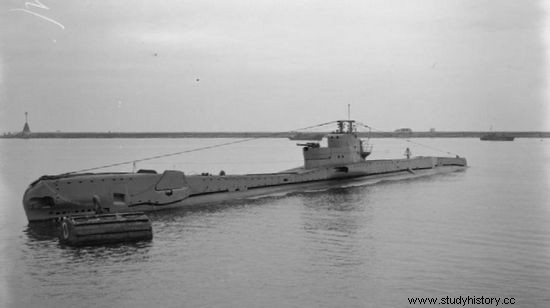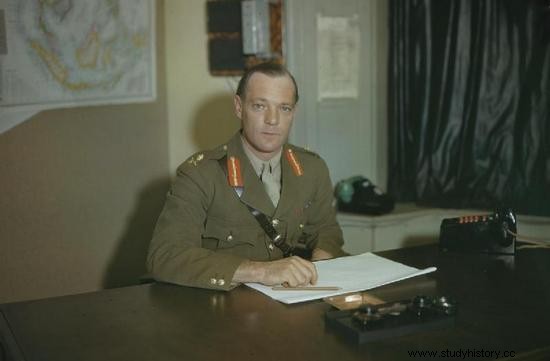This action could change the tide of the war. On the eve of the great desert offensive, the British sent their best commandos into action. The task of the eleventh Commando was to capture or annihilate probably the most dangerous commander of the Third Reich army - Erwin Rommel.
I am writing these words while swimming to do another dirty job. It will definitely not be an easy task. This is my performance, it is my and my people's duty. We have some chances of getting out of this alive. If you get this letter, it means I haven't come back ...
He wrote these words to his fiancée Lt. Col. Geoffrey Keyes aboard the submarine HMS Torbay. A young, only 24-year-old British officer commanded a commando unit, which was given an extremely risky task. He was to kidnap or eliminate the commander-in-chief of the Africa Korps, General Erwin Rommel - the famous "Desert Fox". In addition, British commandos were to attack the headquarters of the Italian army and cut telephone and telegraph connections.
Pedantic British preparation

Lieutenant Colonel Geoffrey Keyes. He was in charge of the commandos to capture or kill Rommel.
The action was given the code name "Flipper". The date of its implementation was set for the night of November 18-19, 1941. It was not an accidental date. It was on 18 November that the counterattack of the British Eighth Army (known as Operation Crusader) was about to begin. Its main goal was to unlock Tobruk. The British idea of using commandos was clever. With one well-aimed blow, they intended to deprive the enemy troops of the commander at a decisive moment and cause chaos in the command structures.
Unit No. 11 Commando (Scottish Commando), which consisted of 6 officers and 53 soldiers. At that time, it was the only branch of this type in the Middle East. All forces were commanded by Brigadier Robert Laycock. Lieutenant Colonel Keyes was in command of the strike team that was to carry out the main task.
November landing
The commandos set sail from Alexandria on November 10 on board two submarines:HMS "Torbay" and HMS "Talisman". Three days later, in the morning, both ships reached the shores of Libya. According to the intelligence, Rommel's headquarters were to be located about 17 kilometers from the coast, in the village of Beda Littoria. Before landing, however, we had to wait until dusk.
The 24-man Geoffrey Keyes strike group was to be the first to land from HMS Torbay. Secondly, the deck of the "Talisman" was abandoned by two units whose task was to attack the nearby Italian camps in Kyrenia and Apolonia. Also on the "Talisman" was Brigadier Laycock, who, according to the plan, headed his group to secure the rear and retreat of the shock formations.

HMS Torbay. One of the two submarines that were used to transport the commandos to perform the "Flipper" action.
The landing site was chosen by the British intelligence officer, Lieutenant John Haselden. This Englishman, born in Egypt and fluent in Arabic, often crossed the German-Italian lines in a Bedouin costume.
It was thanks to him that it was possible to determine the location of Rommel's headquarters and the distribution of security units. Now, on that dark, stormy November evening, he was giving pre-arranged signals with his flashlight to confirm that it was safe to land.
Extremely mean night
The commandos were to reach the shore in rubber pontoons, the so-called dinghy. The weather conditions were very difficult. A strong wind was blowing. A high, storm surge was taking its toll. Landing in such conditions was a real art. Eventually, all the pontoons were landed from the deck of the Torbay, while only 9 commandos, led by Brigadier Laycock, left the Talisman. There were 33 people in total on the shore.
Since the troop forces were smaller than expected, Laycock and Keyes decided to abandon the attack on the Italian camps and focus solely on the main task. Time was pressing and it was time to catch up with Rommel before the British offensive began.
The commandos, led by Keyes and led by Haselden and their Arab guides, went inland. Laycock and three men remained on the coast, hoping that the remaining soldiers aboard the Talisman would try to land again. He was going to lead them then as support for the Keyes squad.
Change of plans
The march towards Beda Littoria was constantly in heavy rain. The commandos slept for the next 48 hours during the day and marched at night. They spent the day of November 17 in a cave, 8 kilometers from Beda Littoria. They set off in complete darkness in the evening. They learned from the Arabs they met by chance that Rommel was not staying in Beda Littoria, but in the nearby Sidi Rafa. Plans had to be modified a bit.

Robert Laycock and his men secured the rear and the retreat of commandos attacking Rommel's headquarters (source:wikimedia commons, public domain).
The squad arrived just after midnight. 400 meters before the village, a group of six soldiers, led by Lieutenant Roy Cook, separated from the main forces. Its task was to cut telephone and telegraph lines. Keyes led the remaining commandos towards the white, stone, two-story building that would be housing Rommel and his staff.
It's not worth waking the dog!
During the approach, the unit was nearly discovered. One of the people accidentally kicked a tin can, causing a dog nearby to bark violently. The door of one of the houses opened. An officer in the uniform of the Italian Arab Libyan Forces came out and asked what was going on. Captain Robin Campbell, Keyes' deputy, replied. He explained in German to the inquisitive Arab that he was dealing with a German patrol. Then he ordered the dog to be silenced, which the enemy officer wished to gute Nacht indeed he did!
Around midnight, the commandos slipped into the alleged Rommel estate, cutting a hole in the mesh surrounding it. Colonel Keyes had silently eliminated the guard standing alone at the main entrance door. The British waited until all the lights in the house went out.

Beda Littoria in a contemporary photo. This is where Erwin Rommel's headquarters was supposed to be located (source:wikimedia commons, public domain).
Unfortunate assault
Lt. Col. Keyes, Capt. Campbell, Sgt. Jack Terry and three more commandos. The rest insured the windows and doors of the building and the approaches to it. Keyes pounded on the door and Capt. Robin Campbell demanded in German that they be admitted. A sentry opened the door. Geoffrey Keyes aimed his revolver at him, but the German, seeing the gun in the lieutenant colonel's hands, grabbed it by the barrel and tried to pull it out. A scuffle began, ended by Campbell with the Thompson series. The sentry was killed, but the commandos lost their greatest asset, surprise.

Sergeant Jack Terry was one of those who would break into the building where Erwin Rommel was allegedly located.
The British, looking for Rommel inside the building, began to "clean" the rooms. They swept them with bursts of machine guns and grenades. There were at least ten Germans in one of the rooms. Keyes, under Campbell's protection, was just dropping a grenade there when a submachine gun burst fired from inside. The lieutenant colonel was shot straight in the heart. Terry and Campbell pulled their commander away and slammed the door shut just as the grenade exploded. A moment later, Keyes died. At the same time, shots could be heard outside. The rest of the Brits fought the approaching German reinforcements.
A few minutes later he was accidentally injured by one of the commandos, Cpt. Campbell. He had a nasty cut to his leg. He ordered Sgt. Take command of Terry, plant the explosives in front of the building, and retreat. He was captured. He refused to let his companions carry him towards the saving coast.
Catchy
The retreat took place in the pouring rain pouring from the sky. The commandos, in gloomy moods due to the death of the commander, leaving Capt. Campbell and an unfulfilled task at around 17.00 they dragged themselves to the coast. There, there was a meeting with a very concerned Brigadier Laycock, who was reported on the operation. The British then hid in the nearby caves, waiting for the submarine boats.
Only HMS Torbay did indeed arrive on time, but the stormy sea prevented the dingha from being launched from its deck. The submersible signaled they would try the next night.

Scottish Commando soldiers. Few of them survived the Flipper action, which turned out to be a complete failure.
Unfortunately, however, the evacuation did not take place. During the day, the British were surrounded by Italian and German troops, notified in advance by local Arabs. Brigadier Laycock, seeing the futility of resisting, ordered the commandos to be divided into groups of two or three and forcing through the desert towards his own troops.
Death, captivity and… champagne birthday

Only two people succeeded. Brigadier Laycock and Sergeant Jack Terry reached their own positions after 41 days' march through the desert. No one else showed up. The rest either died or were captured. Colonel Geoffrey Keyes was awarded the Victoria Cross posthumously for his bravery. It was the first time a commando was honored with this high award.
And Erwin Rommel? At that time, he was neither in Sidi Rafa nor Beda Littoria. His quarters were much closer to the front line. The problem, however, is that he was not even in Africa at the time. He was in Rome, where he and his wife were to celebrate his birthday on November 16 and discuss plans for further campaigns with Italian allies. Lt. Haselden has definitely failed.
